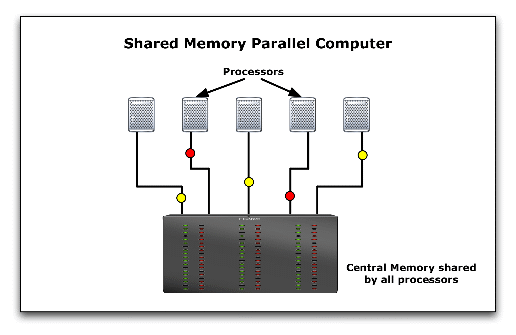Parallel computing
From CFD-Wiki
(→Shared Memory Multiprocessor) |
(→Distributed Memory Multicomputer) |
||
| Line 22: | Line 22: | ||
=== Distributed Memory Multicomputer === | === Distributed Memory Multicomputer === | ||
| + | The distributed memory multicomputer or message passing multicomputer consists of connecting independent computers via an interconnection network as shown in the figure below. Inter-processor communication is achieved through sending messages explicitly from each computer to another using a message passing library such as MPI (Message Passing Interface). In such a setup, as each computer has its own memory address space. A processor can only access its own local memory. To access a certain value residing in a different computer, it has to be copied by sending a message to the desired processor. The message passing multicomputer will physically scale easier than a shared memory multiprocessor, i.e. it can more easily be extended by adding more computers to the network. | ||
| + | |||
==Measuring Parallel Performance== | ==Measuring Parallel Performance== | ||
=== Speedup === | === Speedup === | ||
Revision as of 20:21, 4 December 2005
Contents |
Introduction
Ever heard of "Divide and Conquer"? Ever heard of "Together we stand, divided we fall"? This is the whole idea of parallel computing. A complicated CFD problem involving combustion, heat transfer, turbulence, and a complex geometry needs to be tackled. The way to tackle it is to divide it and then conquer it. The computers unite their efforts to stand up to the challenge!
Parallel computing is defined as the simultaneous use of more than one processor to execute a program. This formal definition holds a lot of intricacies inside. For instance, given a program, one cannot expect to run this program on a 1000 processors without any change to the original code. The program has to have instructions to guide it to run in parallel. Since the work is shared or distributed amongst "different" processors, data has to be exchanged now and then. This data exchange takes place using different methods depending on the type of parallel computer used. For example, using a network of PCs, a certain protocol has to be defined (or installed) to allow the data flow between PCs. The sections below describe some of the details involved.
Types of Parallel Computers
There are two fundamental types of parallel computers
- A single computer with multiple internal processors, known as a Shared Memory Multiprocessor.
- A set of computers interconnected through a network, known as a Distributed Memory Multicomputer.
Each of these can be referred to as a Parallel Computer. In this section we briefly discuss the architecture of the above systems.
A conventional computer consists of a processor and a memory readily accessible by any instruction the processor is executing. The shared memory multiprocessor is a natural extension of the single processor where multiple processors are connected to multiple memory modules such that each memory location has a single address space throughout the system. This means that any processor can readily have access to any memory location without any need for copying data from one memory to another.
Programming a shared memory multiprocessor is attractive for programmers because of the convenience offered by data sharing. However, care must taken when altering values at a given memory location since cached copies of such variables have also to be updated for any processor using that data. Furthermore, simultaneous access to memory locations has to be controlled carefully.
The major disadvantages of the shared memory multiprocessor are summarized in the following:
- Difficult to implement hardware able to achieve fast access to all shared memory locations
- High cost: design and manufacturing complexities
- Short life: upgrade is limited
Distributed Memory Multicomputer
The distributed memory multicomputer or message passing multicomputer consists of connecting independent computers via an interconnection network as shown in the figure below. Inter-processor communication is achieved through sending messages explicitly from each computer to another using a message passing library such as MPI (Message Passing Interface). In such a setup, as each computer has its own memory address space. A processor can only access its own local memory. To access a certain value residing in a different computer, it has to be copied by sending a message to the desired processor. The message passing multicomputer will physically scale easier than a shared memory multiprocessor, i.e. it can more easily be extended by adding more computers to the network.

